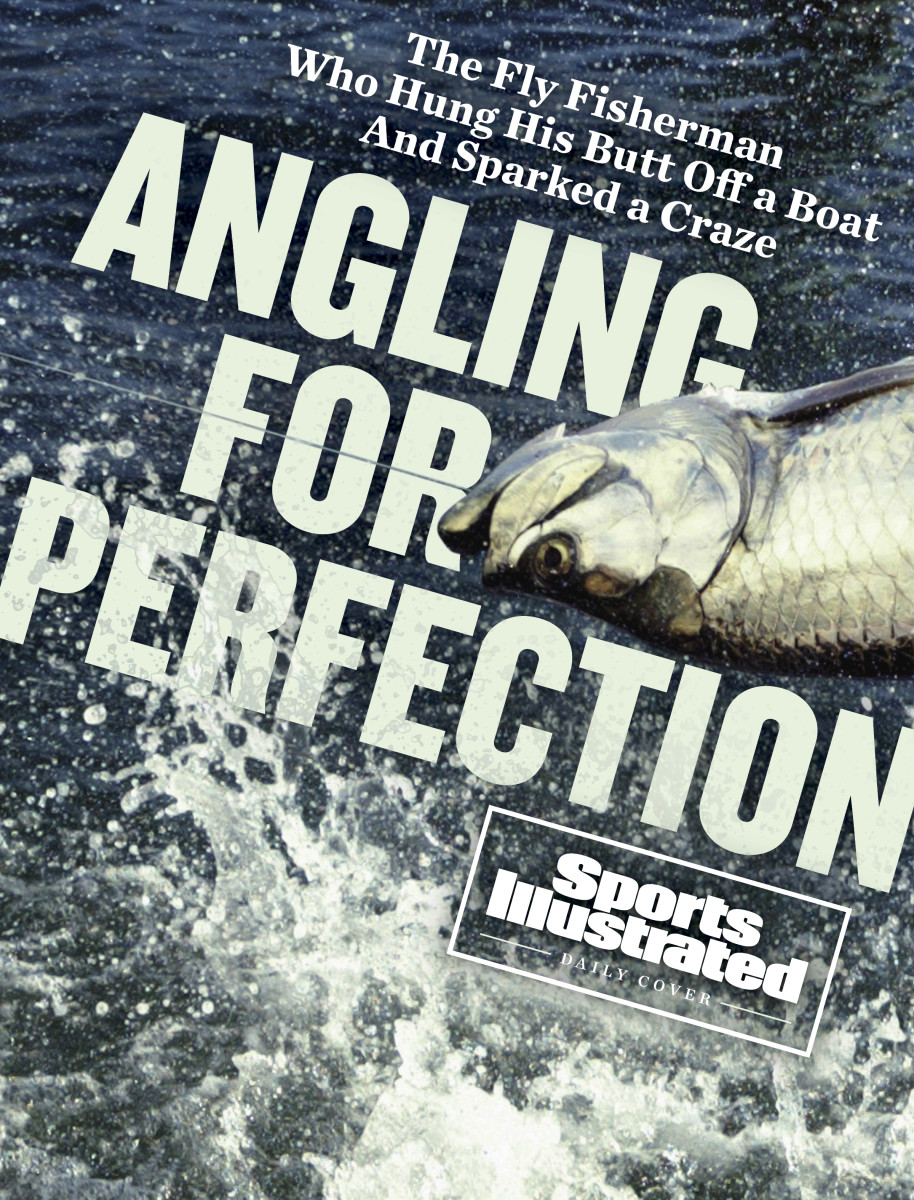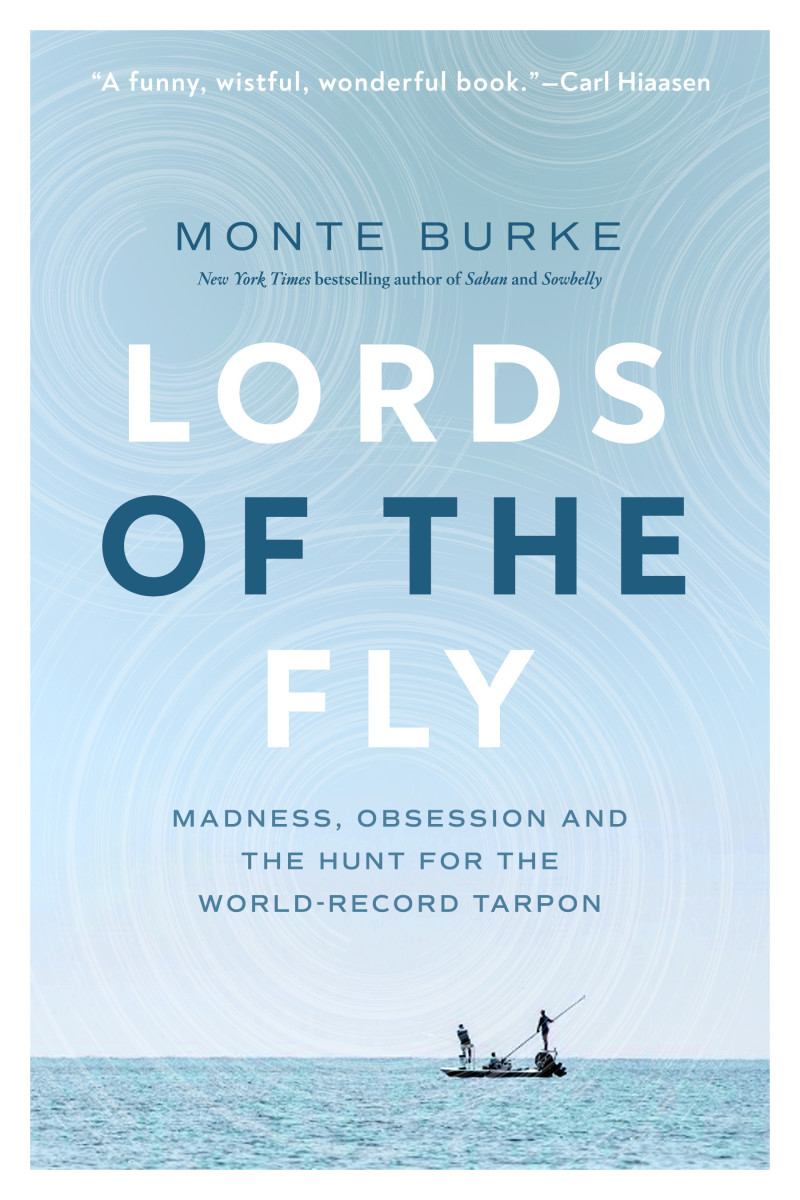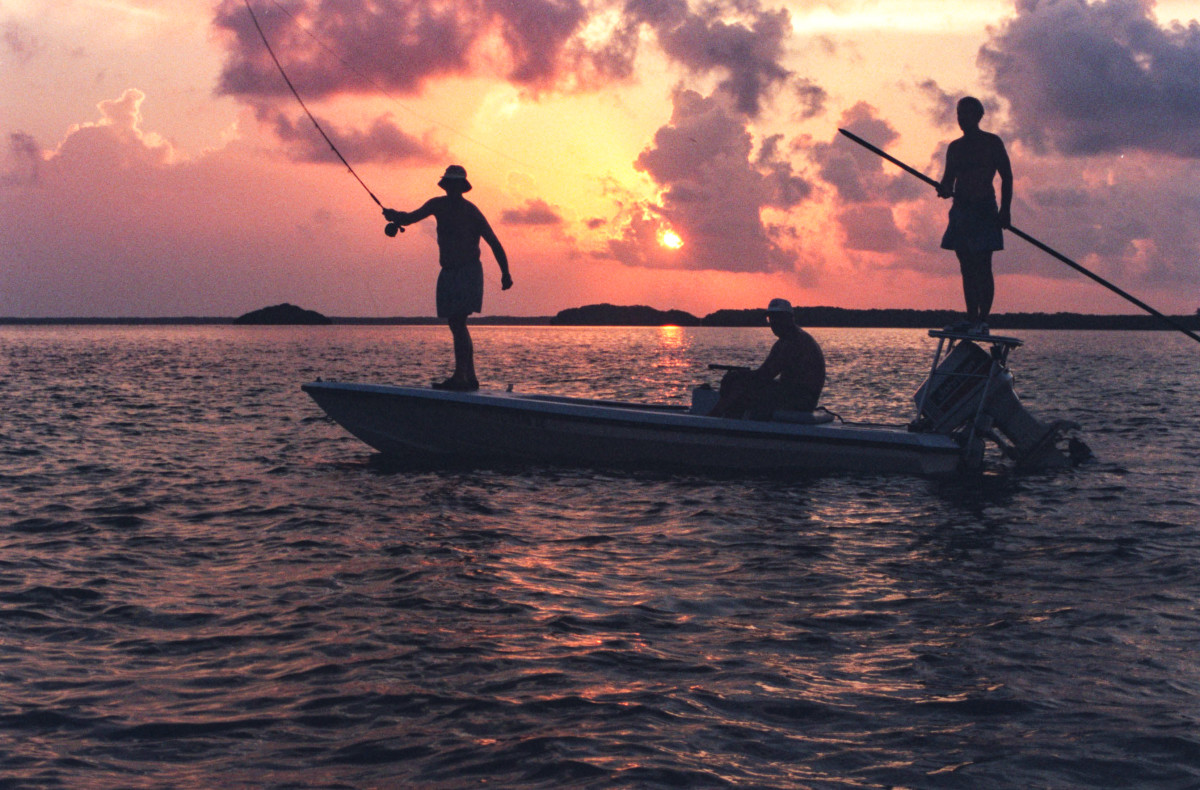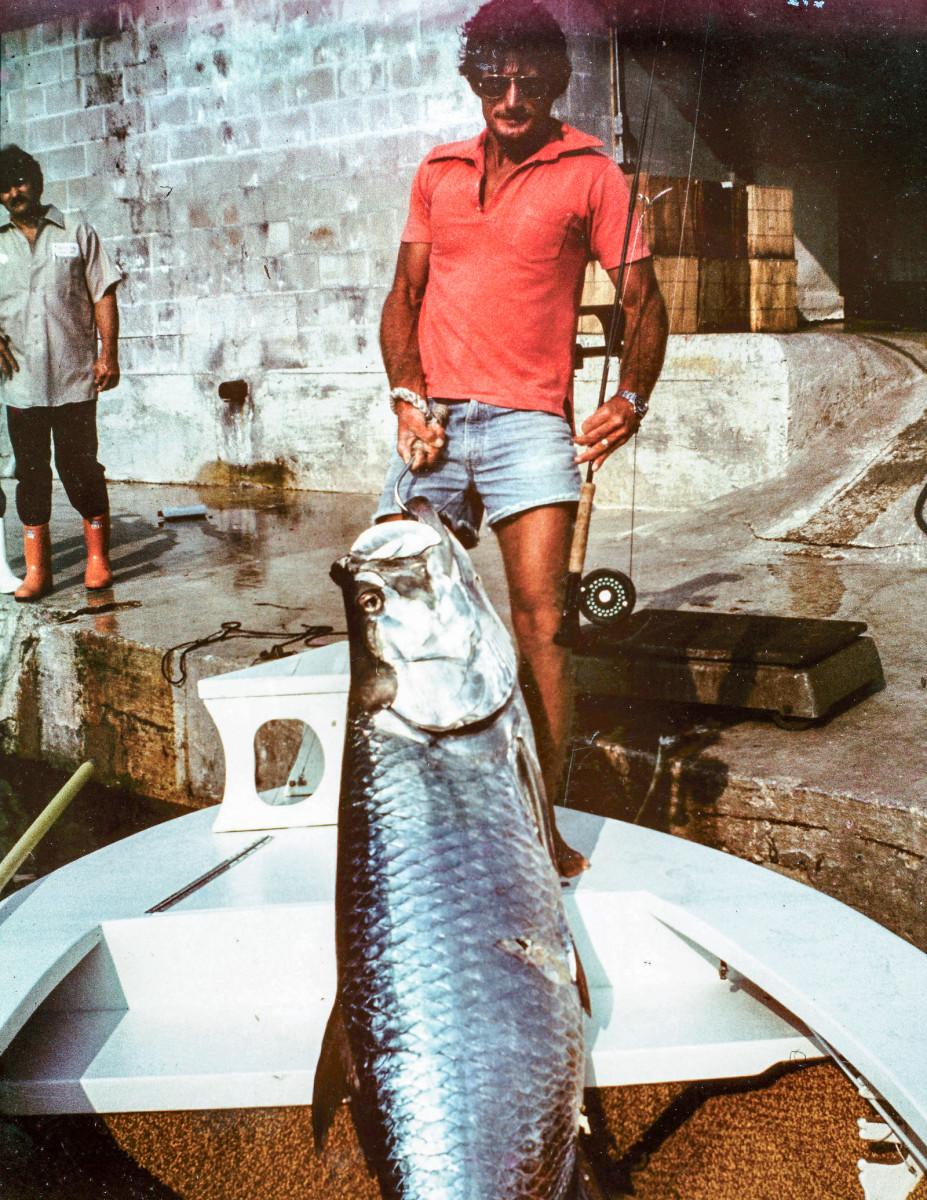A Crappy Boat Ride, a Record Catch and a Fly-Fishing Frenzy
From Lords of the Fly: Madness, Obsession and the Hunt for the World-Record Tarpon, by Monte Burke. ©2020 by Monte Burke. Reprinted by permission of Pegasus Books. All rights reserved.

At daybreak, the cloudless sky was a deep, dark blue. The water rippled gently in the light, westerly breeze. Tom Evans, a stockbroker from New York City, and Steve Huff, a fishing guide from the Florida Keys, sat side by side in the stern of a sixteen-foot, shallow-water skiff, their shoulders slumped slightly forward. They were embarking on their twenty-fourth straight day together on the water.
Huff manned the tiller, slowly idling the boat out of the mouth of the Homosassa River toward the Gulf of Mexico, keeping the wake to a bare minimum, trying to maintain this fleeting moment in a world that felt peacefully reset after a few hours of being left undisturbed by the disharmony of humans. Quail whistled in the gathering light. The roots of the mangroves on the shorelines gripped the river bottom like the fingers of witches. On previous mornings, they’d seen a herd of whiskered manatees lying on their backs, sound asleep, and had dolphins playfully swim beside the boat like dogs greeting a car in a driveway.
On this day—May 24, 1977—the little commercial fishing town some seventy miles north of Tampa, known as Homosassa, was little changed from seven decades prior, when Winslow Homer had captured it and its surroundings in some of the most tranquil of his watercolors. Unbeknownst to Evans and Huff at the time, this day would also mark the beginning of the end of that era.
Though Evans and Huff sat just inches apart from each other, they didn’t speak. They’d dispensed with the usual pleasantries—asking after each other’s families, gossiping about mutual acquaintances—weeks earlier. Now, they saved their words as if to conserve energy. The suffering, which both men withstood and even seemed to relish as it happened, would begin again soon enough. Today, just like the 23 days preceding it and the 21 days yet to come, they would be on the boat for more than 12 straight hours—and on their feet for 11 of those hours—in the glare of an oppressive sun, their eyes trained on the water. Their focus was singular, honed in on a dream they believed could become reality. Any wayward thoughts that happened to enter their minds were discarded quickly. They were acutely aware that any one mistake during the day—a noisy, errant plunk of the push pole used by Huff to move the boat, a blown cast of the fly or a missed hook-set by Evans—could be ruinous. They spoke to each other only when necessary, when fish were spotted or when the time came to reel up and run the boat to another spot. Otherwise, communication was wordless, transmitted by some familiar sixth sense developed during the 150 days they had spent together on the boat over the years, never more than 16 feet apart. They were teammates, in a sense, but each had to rise to the occasion when it came to his individual role. And each sought to execute that role without flaw.

***
The tarpon is the biggest species that fly fishermen target in shallow water, reaching well over 200 pounds. The majority of that fishing is done on the stalk, which makes the sport akin to hunting. And, unlike most fish or even most hunted animals, the tarpon—especially the bigger ones—fight back. They provide a match that in the moment may seem tilted in their favor, that will physically and mentally exhaust anglers to the point that many decide, mid-fight, to break the fish off rather than continue. A tarpon doesn’t like to be hooked, and it will demonstrate this displeasure by cartwheeling, pinwheeling and leaping up to 15 feet out of the water. The pull of a hooked tarpon is, simply put, otherworldly—like suddenly being tethered to a speeding 18-wheeler.
It is a gorgeous fish, silver-plated like a knight’s armor; its acrobatics and spirit are immensely attractive. And yet, any honest tarpon fly fisherman will admit a tinge of fear before embarking on a big tarpon day. Kant once described the sublime as beauty mixed with terror, and the mix of emotions at play here gets at the heart of the addiction, the pull of the pursuit.
The world-record tarpon caught on a fly rod when Evans and Huff headed out that May morning in 1977 was 170 pounds. In their two seasons of fishing in Homosassa—spread over two years—they had seen hundreds of fish they believed were much bigger than that. Evans had even hooked a few, only to lose them when the fish spit the hook, snapped the line or shattered the rod. For now, the world-record tarpon, which they’d come to call “Rocquetta,” was still only potential and not actual.

Preorder Lords of the Fly: Madness, Obsession and the Hunt for the World-Record Tarpon
These tarpon they were seeing in Homosassa, by Evans’s reckoning, were 50% bigger than any he and Huff had seen anywhere else. This presented the duo with something that had once seemed unimaginable, an explosive new reality that they had to figure out.
Over the course of two seasons, they’d spent countless evenings in a motel, forensically recounting each of the fish they’d lost, talking over the different ways in which they could have changed the outcomes. They’d found, after considerable research, new, stronger, laser-sharpened hooks from Japan, fly lines that didn’t disintegrate after hooking and fighting one fish, and a one-piece fiberglass rod that refused to be broken. Huff had also insisted that Evans fight every tarpon he hooked to the boat to be released, even a “Rocky,” which was what they called a fish that was well below the record weight. Huff argued that doing so was a way of respecting the tarpon. He also argued that it served as practice for the big show if and when that moment came.
Evans balked at this idea at first, not wanting to waste time on lesser fish. But he eventually did as Huff requested, and through the process, he learned exactly how much pressure he could exert on the light tippet and figured out how to work the leverage and angles during the fight. In short order, he was routinely getting a hooked tarpon to the side of the boat in under a half hour, three to four times faster than it took most tarpon anglers to do the same.
By that point in the 1977 season, the duo believed they had finally refined their techniques and tackle to the point where actually landing one of the true Homosassa beasts was a possibility.

***
Evans and Huff, physically and temperamentally, appeared to be a mismatched pair. Huff, then 31, weighed around 160 pounds, with long arms, taut as cables, hanging from his lean, compact body. He was born and raised outside of Miami, and he had lived in the Keys and worked as a fishing guide since his early twenties. He was easy with a smile but quiet and philosophical, moral without being preachy, a stickler for the written and unwritten guiding rules. The then-38-year-old Evans, a former collegiate football noseguard and heavyweight wrestler, was all bulk and mass in body and in spirit. He had a growly voice, and he was direct and opinionated and lacked any signs of serious introspection, a bull always very pleased to find himself in a china shop. He called tarpon “the poon.”
They did have some similarities, though. Both had serious issues with wretched fathers—Evans’s dad had kicked him out of the house for good when he was 14, and Huff’s had abandoned his family when the boy was 10. Both men were stubborn to the point of exasperation. Both seemed to enjoy and even welcome pain.
Through quirks of fate, they had found each other, and then found the thing in the fishing world that animated them. And now they were completely in sync, matching both the yearning desire and the prodigious talent it took to pursue, and hopefully catch, Rocquetta.
On this particular morning in 1977, Evans happened to be feeling awful, though. Yes, the 23 straight days of fishing had taken a toll, on both body and mind. But for Evans, the bigger issue was his diet. He still had the capacious appetite, if not the metabolism, of a collegiate football player. The sleepy town of Homosassa didn’t offer much in the way of dining options back then, and the nearest grocery store was a 45-minute drive away, a trip neither man was willing to endure at 7:30 p.m. after 12 hours or more on the water. So Evans had ended up eating—eating a lot—at the same local fish shack every night, and the fried food had finally caught up with him. Staying in the motel during the day to recover was not an option for Evans, not with just a few weeks left in prime tarpon season in Homosassa. So he went out on the water despite the discomfort.
At one point during the day, as Huff was poling the boat near an area known as Chassahowitzka Point, Evans’s sickness became overwhelming. He made his way to the stern, pulled down his pants and hung off the back of the boat. Huff anchored and moved to the bow, giving Evans every inch of space he could, and he continued to scan the water for fish. Almost immediately, he spotted something in the distance. Tarpon. A school of perhaps 20 fish was headed toward the boat, fast.
Huff told Evans to hurry up. To which Evans reported back: There was no way he could do that; Huff should take a shot at the fish. Huff told Evans he could not do that. He was a guide, after all, paid by the client to get the client into fish. The school of tarpon was now swiftly gaining on the boat.
“Goddammit, Steve, just do it!” Evans yelled.
Huff looked down at the fly rod on the bottom of the boat. He paused for a moment, paralyzed by indecision. Then he grabbed the rod and started to quickly strip out enough line to make a cast.
It turned out he had waited too long. By the time he worked out a cast, the fish had seen the boat and flushed off, their giant tails creating whirlpools in the water, propelling them instantaneously out of sight. Huff felt both disappointed and relieved. He began to reel in the line. Evans still hung off the back.
But just then, Huff spotted two new fish coming in, tracking along the same route as the previous school. Without any hesitation this time, he made a cast at what appeared to be the larger of the duo, placing the three-inch fly—made with chicken feathers and a large, two-inch hook—five feet ahead of it. As the tarpon neared, he made one long, slow strip of the line.
The fish veered toward the fly, engulfed it and leapt, its body lurching completely out of the water before crashing back in. It was, as Huff would later recall, as if someone had dropped a Steinway piano into the ocean from a helicopter.
Though much smaller than Evans, Huff was equally adept at fighting fish, and after 20 minutes the tarpon lay in the water beside the boat, exhausted and defeated. The fish was utterly enormous, bigger by some degree, Huff says, than any tarpon he had ever seen. He turned to Evans, who was finally finished with his business, and asked him to gaff the fish. Huff believed he would never catch a bigger tarpon in his life, and he wanted to have it mounted. Evans wanted to gaff it, too—he needed to see exactly how big the fish was, so he’d know, definitively, where the mark now stood.
With that settled, Evans picked up the eight-foot-long kill gaff, with its massive barbed hook, reached it out over the tarpon, and violently yanked it back with all his force into the fish’s massive silver flank. It was the first and last fish Evans would ever gaff. With two hands and all of his strength—and with some help from Huff—the tarpon was hauled into the boat, where it lay, motionless.
“That’s Rocquetta,” Evans said, in barely more than a whisper, and then went silent. Water lapped onto the sides of the rocking boat. The two men drew and expelled heavy, adrenalized breaths. After a few moments, Huff picked up his push pole and started moving the boat and searching the water for fish. Evans took to the bow. The men were each going through emotions that veered from one extreme to the other—emotions that would, at some point, need to be hashed out. And yet they fished for another four hours, speaking only when necessary (Huff: “Fish coming in at one o’clock;” Evans: “I see them”), all the while trying, but failing, to ignore the giant dead tarpon splayed across the boat’s bottom.
They didn’t hook another fish. And finally, as the sun sank into the Gulf and the translucence of the water grew dull, Huff cranked up the motor and vectored the boat toward the commercial fish house onshore that had a certified scale. The two men sat next to each other in the back of the boat in silence, ending the day just as they’d begun it, even though everything had changed.

At the fish house, the scale read 186 pounds. Huff’s tarpon had bested the standing world record by 16 pounds.
“Well, you did it, Steve,” Evans said.
“No,” replied Huff. “I didn’t.” His feelings about the giant fish had left him vexed. Catching it had proved exhilarating. And yet he bore a slight sense of regret for even picking up the rod and making the cast in the first place.
Over Evans’s protestations, Huff decided he would not submit the tarpon for official certification as the new world record. He was a fishing guide, and he had been paid to do precisely that job on that day. By Huff’s unwritten code, that disqualified him and the fish for world-record consideration. And Evans quickly realized that Huff was too stubborn to be dissuaded on this point.
But even though Huff never did submit his tarpon, and nothing was ever made official, Evans knew that the new level had been established. The potential had become actual. And word got out.
***
Huff’s fish ignited a frenzied five-year run—from the late ’70s into the early ’80s—unlike anything ever before seen in the angling world. Or ever to be seen again. The previously-undiscovered Homosassa became an epicenter, the place where the best fly anglers in the world gathered each spring with the same goal: break the world record for the most glamorous and sought-after fly rod species. The tarpon.
Joining Evans and Huff on the water were Stu Apte, Billy Pate, Al Pflueger Jr., Flip Pallot and Chico Fernandez, plus Legends of the Fall author Jim Harrison and Red Sox Hall of Famer Ted Williams, among others. Media attention followed. The Associated Press, The New York Times and Sports Illustrated ran feature stories about the chase for the world record. ABC aired a television special. The conglomerate 3M produced a movie.
All the while, the converging egos turned the atmosphere in Homosassa electric. The difficulty of the quest made it legitimate. And the drugs and other vices that swept in with the tide led it all to veer out of control.
The men chasing the tarpon world record in Homosassa were driven by obsession. And while obsessions—like climbing Mount Everest or pulling off some long-distance swim—can seem trivial, nonsensical or naïve, they are what make the world go ‘round. What gives shape and definition and meaning to lives. Taken too far, of course, they become dangerous and harmful. “I desire the things which destroy me in the end,” Sylvia Plath once wrote in her journal.
The world record fell nearly every year during those heady years in Homosassa. But records weren’t the only things broken. Hooks, lines, rods, reels, hearts, marriages and, ultimately, the fishery itself, didn’t survive, either. The place came to be known as “Homosmasha.”
“I’ve never seen a group of people fall faster,” says Evans. “If you let the poon totally grab hold of your life, it shattered it.”
In the end, the large masses of tarpon disappeared from Homosassa, the combined result of overcrowding on the water and Florida’s shameful and willful mismanagement of its natural resources, its coastlines overdeveloped without thought of fragile ecosystems, its freshwater—vital to the health of coastal areas—diverted and used and polluted by multinational corporations and developers in the name of growth. The record-chasing anglers—some able to recover and move on, some broken for good—all left, too, never to return.
That is, except for one man.
***
Forty-two years after Huff’s catch, I am sitting in the stern of a boat that was designed, constructed and eventually sold off by a prominent Miami gangster, who is now deceased. We are floating off of Homosassa, on an enormous white sand flat that’s nearly 30 miles long, interrupted here and there by piles of dark black rocks. This flat is known to anglers and guides as Oklahoma for its wide-open vastness, and it was once perhaps the best spot in the world to catch a giant tarpon. It is 11 in the morning. The sky is clear, the wind light, the sun blazing hard enough to induce a squint behind your sunglasses.
The boat is being moved, quietly and with purpose, by a man named Al Dopirak, a fishing guide who hails from nearby Pinellas County. He stands above me, on the platform atop his boat’s motor, rhythmically, and without any evident effort, placing his 18-foot graphite push pole in the water until he finds purchase on the sea’s floor, then pushing it, gloved hand over gloved hand to its top end, then pulling and sliding the pole back up through his hands and doing it all over again. He never once takes his eyes off the water—in front of the boat, beside it and, occasionally, behind it. Dopirak, 63, is blue-eyed and deeply (seemingly permanently) tanned. He has a cotton-white goatee and blonde-streaked hair that nearly reaches his shoulders. He looks like a younger, leaner Jeff Bridges; a South Florida cowboy of the flats. He prefers to address everyone and anyone as “Dawg.”
In the front, standing on the bow and gazing out over the sea with his hands monkishly clasped behind his back, is the Australian, Dean Butler. He is one of the world’s finest deep-sea fly-fishing guides, despite the fact that he lost the use of two fingers on his right hand—the pinky and the ring—when he fell through a transom door while trying to land a marlin and had two tendons cleanly cleaved by the boat’s propeller as he surfaced. He is here in Homosassa as a quasi first mate—a potential gaffer, a manager of rods, a tyer of knots and leaders and flies, another set of eyes on the water, a chef, a bartender, and a grocery-getter. Butler is 56 and sports a perpetual grin under his salt-and-pepper goatee. His blue eyes contain within them an unmistakable hint of mischief. He rarely utters a sentence without using the word f--- in some form. Presently, he turns to us, behind him in the boat, and says, “It feels like it’s going to happen today,” then turns back around to again watch the water. With only a slight turn of his head this time, he adds as an afterthought, “I base that on f--- all, of course.”

Butler is addressing Dopirak and me, yes—but the main intended audience is the 82-year-old man sitting in a lawn chair placed just in front of the steering console. This man is tall and weighs somewhere north of 300 pounds. He has a battery implanted in his back that’s meant to inspire his nerves to fire correctly. An orange hat rests upon his white hair. His dark sunglasses are held onto his head by a pair of Croakies that read “Life is too short to drink cheap wine.” He wears a purple long-sleeved T-shirt with pictures on the back of the numerous world-record tarpon that he caught during Homosassa’s glory years. His feet, swollen and covered in liver spots, are propped on the elevated bow area in front of him.
Tom Evans has come back to Homosassa in search of a world-record tarpon in 41 of the past 43 years. Most of those trips were at least a month long, meaning that he’s spent somewhere between 1,200 and 1,500 days here, or close to three and a half years of his life. He was here for Homosassa’s glory years, and for its precipitous fall. There have been many years during that time when he’d spend a month on the water and catch only three or two or one or, sometimes, no tarpon at all. Because of his back problems, his age and his weight, he can no longer stand for more than a few moments. He is back again this year for what could very well be his last time.
But Evans does not hear Butler’s comment because he is, well, currently sound asleep. His chin is on his chest. His rotund abdomen lifts and falls in rough rhythm with the rocking boat. It’s a state in which he has been for the past half hour, interrupted only twice by identical guttural utterances:
“C’mon, poon.”
Read more of SI's Daily Covers stories here

